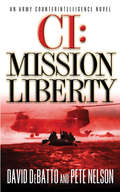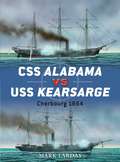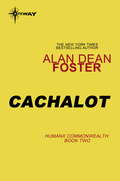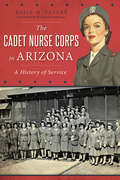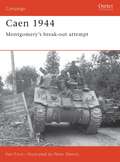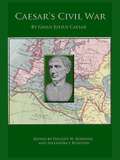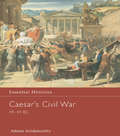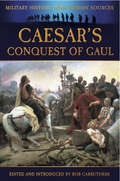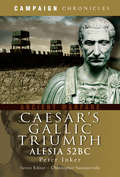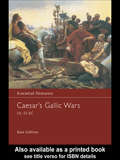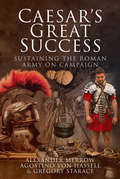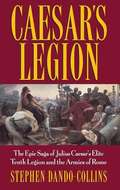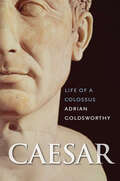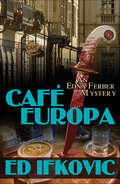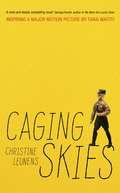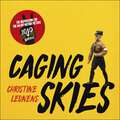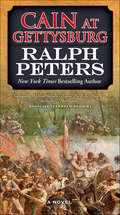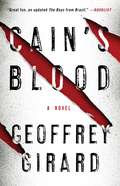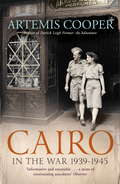- Table View
- List View
CI #3: Mission Liberty
by David Debatto Pete NelsonThis third thrilling espionage novel in the exciting CI series finds special agent David DeLuca up against those responsible for mass suffering in the war-torn African country of Niger.
CI #4: Homeland Threat
by David Debatto Pete NelsonIn the fourth novel of this thrilling series, the Pentagon suspects that the brutal murder of the daughter of a revered Army general is tied to a string of deadly assassinations of U.S. military personnel. Counterintelligence Staff Sergeant David DeLuca and his CI team of specialists are brought in to investigate.
CLEP® Western Civilization II Book + Online (CLEP Test Preparation)
by Preston JonesEarn College Credit with REA’s Test Prep for CLEP Western Civilization II: 1648 to the Present Everything you need to pass the exam and get the college credit you deserve. REA leads the way in helping students pass their College Board CLEP exams and earn college credit while reducing their tuition costs. With 25+ years of experience in test prep for the College-Level Examination Program (CLEP), REA is your trusted source for the most up-to-date test-aligned content. Whether you’re an adult returning to finish your degree, a traditional-age college student, a military service member, or a high school or home-schooled student looking to get a head start on college and shorten your path to graduation, CLEP is perfect for you. REA’s expert authors know the CLEP tests inside out. And thanks to our partners at Proctortrack (proctortrack.com/clep), you can now take your exam at your convenience, from the comfort of home. Prep for success on the CLEP Western Civilization II exam with REA’s personalized three-step plan: (1) focus your study, (2) review with the book, and (3) measure your test-readiness. Our Book + Online prep gives you all the tools you need to make the most of your study time: Diagnostic exam: Pinpoint what you already know and what you need to study.Targeted subject review: Learn what you’ll be tested on.Two full-length practice exams: Zero in on the topics that give you trouble now so you’ll be confident and prepared on test day.Glossary of key terms: Round out your prep with must-know vocabulary.REA is America’s recognized leader in CLEP preparation. Our test prep helps you earn valuable college credit, save on tuition, and accelerate your path to a college degree.
CSS Alabama vs USS Kearsarge
by Peter Dennis Mark LardasBy the time of American Civil War things had changed from the Age of Fighting Sail - steam power and explosive shells were transforming naval warfare. Iron was beginning to supplant wood. Britain had just finished HMS Warrior, an iron-hulled warship and coastal ironclads dominated the waters off the United States. The changes meant that ships sank, during battles instead of afterwards. The fights were no less bloody, but in addition to flying splinters, a host of other dangers were added - burst steam boilers, fire due to exploding shells, and the burst from the shells themselves. But, just as in the age of sail, warship captains that won one-on-one battles with another warship became as famous as modern sports stars. During the course of the American Civil War, three single ship actions were fought between Union cruisers and Confederate raiders: CSS Florida vs. USS Wachusett, CSS Alabama vs. USS Hatteras, and CSS Alabama vs. USS Kearsarge. This book will present those, with an emphasis on the most famous battle: Alabama's fight with Kearsarge. Next to the battle between USS Monitor and CSS Virginia, no other naval duel of the American Civil War drew as much interest. That story is told from the eyes of the participants filtered through the lens of historical analysis available since the battles were fought. This includes archeological studies of wrecks of some of these ships, making this book an indispensible guide for anyone interested in Civil War and naval history.From the Trade Paperback edition.
Cable Car Carnival
by Lucius BeebeOriginally published in 1951, this is a richly illustrated paean to San Francisco’s cable cars dating from the years when they were in jeopardy and were eventually saved (though not entirely) through the efforts of activist citizens.
Cachalot
by Alan Dean FosterA guilt-ridden Earth had turned Cachalot over to the few surviving cetaceans as a perpetual refuge - a planet whose surface was one great ocean, where the remnants of the whales, porpoises and dolphins could pursue their lives and perhaps even the development of an intelligence even greater than man's. Humans on Cachalot were strictly confined to a few islands and the floating towns, prospering from the wealth of its sea. The cetaceans seemed to have forgiven the thousands of years of terror and slaughter they had suffered - some had even befriended selected humans.But something was destroying the towns of Cachalot - leaving no clues...or survivors.
Cadet Nurse Corps in Arizona, The: A History of Service (Military)
by Richard Carmona Elsie M. SzecsyCongress established the U.S. Cadet Nurse Corps during World War II to meet the high demand for medical care. The first federal women's education program, it included a nondiscrimination policy decades before the civil rights movement. The trailblazing cadets and innovative healthcare practices at the five participating teaching hospitals in Arizona left a lasting national legacy. Sage Memorial Hospital was the country's only accredited nursing school for Native Americans. Santa Monica's Hospital and nursing school was the first to integrate west of the Mississippi. The daughter of a Navajo medicine man, U.S. Army Nurse Corps second lieutenant Adele Slivers helped bridge a gap between traditional healing practices and modern medicine. Arizona author Elsie Szecsy details momentous local challenges and achievements from this pivotal era in American medicine.
Caen 1944
by Peter Dennis Ken FordOne of the key objectives of British forces on D-Day during World War II (1939-1945)was the capture of the strategically vital city of Caen. General Montgomery saw Caen as the key to Normandy and the springboard for the Allied breakout, but so did the Germans and the city did not fall. It took three major offensives and more than 30 bloody days of struggle to finally take Caen. In the process the city was controversially devastated and its civilian population decimated. The Allies paid a high price for Caen but the horrific German casualties bled their forces in Normandy white and helped open the way for the American breakout in Operation Cobra.
Caesar's Civil War
by Gaius Julius Caesar Alexandra L. Rospond Vincent W. RospondJulius Caesar provides a history of the Civil War against Pompey and the Optimates, describing the events that led up to war and the actions he was required to take to secure victory. This edition provides an edited narrative with appendices to give background to the era.
Caesar's Civil War 49-44 BC: 49-44 Bc (Essential Histories)
by Adrian GoldsworthyFirst published in 2004. Routledge is an imprint of Taylor & Francis, an informa company.
Caesar's Conquest of Gaul: The Illustrated Edition (Military History from Primary Sources)
by Bob CarruthersThe Gallic Wars were a series of military campaigns waged by the Roman proconsul Julius Caesar against several Gallic tribes. They lasted from 58 BC to 50 BC and culminated in the decisive Battle of Alesia in 52 BC, in which a complete Roman victory resulted in the expansion of the Roman Republic over the whole of Gaul. The wars paved the way for Julius Caesar to become the sole ruler of the Roman Republic.Although Caesar portrayed this invasion as being a preemptive and defensive action, most historians agree that the wars were fought primarily to boost Caesar's political career and to pay off his massive debts. Still, Gaul was of significant military importance to the Romans, as these had been attacked several times by native tribes both indigenous to Gaul and further to the north. Conquering Gaul allowed Rome to secure the natural border of the river Rhine.The Gallic Wars are described by Julius Caesar as himself in this book, which was originally titled Commentarii de Bello Gallico, it is a pertinent and only slightly tendentious and altogether the most important historical source regarding the conflict. This updated edition contains the translated text and various illustrations depicting Roman warfare and key moments in Caesar's journey.
Caesar's Gallic Triumph: Alesia 52BC (Campaign Chronicles)
by Peter InkerAn ancient historian vividly reconstructs—and persuasively reassesses—the Roman Empire&’s most significant victory of the Gallic Wars. In 52 B.C., Julius Caesar pulled off one of the great feats of Roman arms in what is now Burgundy, France. His heavily outnumbered army utterly defeated the combined forces of the Gallic tribes led by Vercingetorix and completed the Roman conquest of Gaul. The Alesia campaign, and the epic siege in which it culminated, was one of Caesar&’s finest military achievements, and it has fascinated historians ever since. In Caesar&’s Gallic Triumph, Peter Inker reconstructs the battle in graphic detail, combining ancient and modern sources and evidence derived from archaeological research. He questions common assumptions about the campaign, reassesses Caesar's own account of events, and looks again at aspects of the battle that have been debated or misunderstood. His gripping account gives new insight into Caesar the commander and into the Roman army he commanded.
Caesar's Gallic Wars 58-50 BC: 58-50 Bc (Essential Histories #43)
by K. M. GilliverFirst published in 2004. Routledge is an imprint of Taylor & Francis, an informa company.
Caesar's Great Success: Sustaining the Roman Army on Campaign
by Agostino von Hassell Alexander Merrow Gregory StaraceAn in-depth look at the world’s first ever military logistical supply system and how it fed Caesar’s armies in the field.Logistics have become a principal, if not a governing factor, in modern military operations. Armies need to be fed and supplied, and the larger the army, the greater the logistical difficulties that have to be overcome. Two thousand years ago, when communications were far more primitive, the size of armies was limited by the difficulties of supply. It was because the Romans developed a sophisticated supply system that they were able to maintain large armies in the field—armies that conquered much of the then known world.In Caesar’s Great Success, the authors examine and detail the world’s first ever fully-developed logistical supply system—the forerunner of today’s complex arrangements. This includes an examination of the sea, river, and land transportation of food while on campaign, and of how the food was assembled at the operational bases and subsequently distributed.The defense of the Roman food supplies, and especially of lines of communication, was an important factor in Caesar’s operational planning, as was interdicting the enemy’s supplies.The eating habits of Caesar’s men are considered and what items could be obtained locally by forage and which were taken by requisition—and how much food a legionnaire was expected to carry on campaign.With this, the nature of the actual food consumed by the legionnaires is therefore examined and sample recipes are provided with each chapter of the book to enable the reader to relive those momentous days when Caesar and Rome ruled the world.
Caesar's Legion: The Epic Saga of Julius Caesar's Elite Tenth Legion and the Armies of Rome
by Stephen Dando-CollinsA study of the Tenth Legion and Roman armies in general from the time of Caesar to the time of Vespasian.
Caesar: Life of a Colossus
by Adrian GoldsworthyThis &“captivating biography&” of the great Roman general &“puts Caesar&’s war exploits on full display, along with his literary genius&” and more (The New York Times) Tracing the extraordinary trajectory of the Julius Caesar&’s life, Adrian Goldsworthy not only chronicles his accomplishments as charismatic orator, conquering general, and powerful dictator but also lesser-known chapters during which he was high priest of an exotic cult and captive of pirates, and rebel condemned by his own country. Goldsworthy also reveals much about Caesar&’s intimate life, as husband and father, and as seducer not only of Cleopatra but also of the wives of his two main political rivals. This landmark biography examines Caesar in all of these roles and places its subject firmly within the context of Roman society in the first century B.C. Goldsworthy realizes the full complexity of Caesar&’s character and shows why his political and military leadership continues to resonate thousands of years later.
Cafe Europa (Edna Ferber Mysteries #Bk. 6)
by Ed Ifkovic"Ifkovic successfully blends homicide with a loving homage to Budapest on the eve of World War I." —Kirkus ReviewsIn 1914, as rumors of war float across Europe, Edna Ferber travels to Budapest with Winifred Moss, a famous London suffragette, to visit the homeland of her dead father and to see the sights. Author Edna is fascinated by ancient Emperor Franz Joseph and by the faltering Austro-Hungarian Empire, its pomp and circumstance so removed from the daily life of the people she meets. Sitting daily in the Café Europa at her hotel, she listens to unfettered Hearst reporter Harold Gibbon as he predicts the coming war and the end of feudalistic life in Europe while patrons chatter.Then a shocking murder in a midnight garden changes everything.Headstrong Cassandra Blaine is supposed to marry into the Austrian nobility in one of those arranged matches like Consuela Vanderbilt's still popular with wealthy American parents eager for titles and impoverished European nobility who have them to offer. But Cassandra is murdered, and her former lover, the dashing Hungarian Endre Molnár, is the prime suspect. Taken with the young man and convinced of his innocence, Edna begins investigating with the help of Winifred and two avant-garde Hungarian artists. Meanwhile possible war with Serbia is the topic of the day as Archduke Franz Ferdinand prepares to head to Sarajevo. While the world braces for disaster, Edna uncovers the truth—and it scares her.
Cage Fight: Civilian and Democratic Pressures on Military Conflicts and Foreign Policy
by Bruce S. ThorntonSince the birth of democracy, the political institutions that protect the freedom and rights of citizens—regular elections, the right to speak freely and express dissent—have been potentially dangerous in times of war and conflict by complicating and interfering with the policies and decisions that require swift execution, decisiveness, and persistence. In the United States, the military establishment is subordinate to civilian institutions and offices that are accountable to the citizens, leading to often contentious relations.The five essays in this book examine these complex civilian–military relations. Paul Rahe describes a famous example of the excesses of direct democracy in ancient Athens; Ralph Peters analyzes the Civil War from the perspective of dissent, resistance, and riot; Peter Mansoor provides a history of military disagreement with the commander in chief in peacetime; Williamson Murray covers the concerns of American isolationism during the Cold War and the Korean War; and Bing West offers a study of dissent within the military around failing strategies. In his epilogue, Victor Davis Hanson outlines President Trump's stormy relationships with his military cabinet members, illustrating many of the tensions and dangers that have characterized the principle of civilian control of the military.
Caged Eagles (Sequel To: War of the Eagles)
by Eric WaltersWhen Canada went to war with Japan following the bombing of Pearl Harbor, Canadians of Japanese descent were declared "Enemy Aliens". Without recourse of any kind, they were forced to leave their homes along the British Columbia coast, their possessions were sold, and their rights as citizens denied. Sequel to War of the Eagles.
Caging Skies: THE INSPIRATION FOR THE MAJOR MOTION PICTURE 'JOJO RABBIT'
by Christine LeunensTHE INSPIRATION FOR THE OSCAR-NOMINATED MOTION PICTURE 'JOJO RABBIT'NOMINATED FOR 6 ACADEMY AWARDS INCLUDING BEST PICTURE AND BEST ADAPTED SCREENPLAYThis extraordinary novel is seen through the eyes of Johannes, an avid member of the Hitler Youth in the 1940s. After he is severely injured in a raid, he discovers his parents are hiding a Jewish girl called Elsa behind a false wall in their large house in Vienna. His initial horror turns to interest, then love and obsession. After the disappearance of his parents, Johannes finds he is the only one aware of Elsa's existence in the house, the only one responsible for her survival. Both manipulating and manipulated, Johannes dreads the end of the war: with it will come the prospect of losing Elsa and their relationship, which ranges through passion and obsession, dependence and indifference, love and hate.This gripping, masterful work examines truth and lies at both political and personal levels, laying bare the darkest corners of the human soul.
Caging Skies: THE INSPIRATION FOR THE MAJOR MOTION PICTURE 'JOJO RABBIT'
by Christine LeunensTHE INSPIRATION FOR THE MAJOR MOTION PICTURE 'JOJO RABBIT'6 ACADEMY AWARD NOMINATIONS INCLUDING BEST PICTURE AND BEST ADAPTED SCREENPLAYA gripping, atmospheric novel about obsession and love in war-time ViennaThis extraordinary novel is seen through the eyes of Johannes, an avid member of the Hitler Youth in the 1940s. After he is severely injured in a raid, he discovers his parents are hiding a Jewish girl called Elsa behind a false wall in their large house in Vienna. His initial horror turns to interest, then love and obsession. After the disappearance of his parents, Johannes finds he is the only one aware of Elsa's existence in the house, the only one responsible for her survival. Both manipulating and manipulated, Johannes dreads the end of the war: with it will come the prospect of losing Elsa and their relationship, which ranges through passion and obsession, dependence and indifference, love and hate.This gripping, masterful work examines truth and lies at both political and personal levels, laying bare the darkest corners of the human soul.(P) 2019 Hodder & Stoughton Ltd
Cain at Gettysburg: A Novel (The Battle Hymn Cycle #1)
by Ralph PetersThe New York Times–bestselling author “surpasses Michael Shaara’s classic The Killer Angels” with this stirring novel of the Civil War’s most epic battle (Booklist, starred review)Two mighty armies blunder toward each other, one led by confident, beloved Robert E. Lee and the other by dour George Meade. They’ll meet in a Pennsylvania crossroads town where no one planned to fight. In this sweeping novel, the greatest battle ever fought on American soil explodes into life.Following a tough Confederate sergeant from the Blue Ridge, a bitter Irish survivor of the Great Famine, a German political refugee, and gun crews in blue and gray, Cain at Gettysburg is as grand in scale as its depictions of combat are unflinching.Through three brutal days of combat, James Longstreet is haunted by a vision of war that leads to a fateful feud with Robert E. Lee. Scheming Dan Sickles nearly destroys his own army. Gallant John Reynolds and obstreperous Win Hancock, fiery William Barksdale and dashing James Johnston Pettigrew, gallop toward their fates. . . . Winner of the American Library Association’s W.Y. Boyd Award for Excellence in Military Fiction
Cain's Blood: A Novel
by Geoffrey GirardWhen clones of infamous serial killers escape from a secret government facility, it's up to a former Army Ranger to stop them...with the help of a teenage killer clone.The DNA of the world's most notorious serial killers--including Ted Bundy, The Son of Sam, and The Boston Strangler--has been cloned by the US Department of Defense to develop a new breed of bioweapon. Now in Phase Three, the program includes dozens of young men who have no clue as to their evil heritage. Playing a twisted game of nature vs. nurture, scientists raise some of the clones with loving families and others in abusive circumstances. But everything changes when the most dangerous boys are set free by their creator. A man with demons of his own, former black ops soldier Shawn Castillo is hot on the clones' trail. But Castillo didn't count on the quiet young man he finds hiding in an abandoned house--a boy who has just learned he is the clone of Jeffrey Dahmer. As Jeffrey and Castillo race across the country after the rampaging teens, Castillo must protect the boy who is the embodiment of his biggest fears--and who may also be his last hope. "A wild, peek-through-your fingers scare ride" (Paul Tremblay, author of The Little Sleep), Cain's Blood melds all-too-plausible science and ripped-from-the-headlines horror into a stunning work about the potential for good and evil in us all.
Cairo in the War: 1939-45
by Artemis CooperFor troops in the desert, Cairo meant fleshpots or brass hats. For well-connected officers, it meant polo at the Gezira Club and drinks at Shepheard's. For the irregular warriors, Cairo was a city to throw legendary parties before the next mission behind enemy lines. For countless refugees, it was a stopping place in the long struggle home. The political scene was dominated by the British Ambassador Sir Miles Lampson. In February 1942 he surrounded the Abdin Palace with tanks and attempted to depose King Farouk. Five months later it looked as if the British would be thrown out of Egypt for good. Rommel's forces were only sixty miles from Alexandria - but the Germans were pushed back and Cairo life went on. Meanwhile, in the Egyptian Army, a handful of young officers were thinking dangerous thoughts.
Cairo in the War: 1939-45
by Artemis CooperFor troops in the desert, Cairo meant fleshpots or brass hats. For well-connected officers, it meant polo at the Gezira Club and drinks at Shepheard's. For the irregular warriors, Cairo was a city to throw legendary parties before the next mission behind enemy lines. For countless refugees, it was a stopping place in the long struggle home. The political scene was dominated by the British Ambassador Sir Miles Lampson. In February 1942 he surrounded the Abdin Palace with tanks and attempted to depose King Farouk. Five months later it looked as if the British would be thrown out of Egypt for good. Rommel's forces were only sixty miles from Alexandria - but the Germans were pushed back and Cairo life went on. Meanwhile, in the Egyptian Army, a handful of young officers were thinking dangerous thoughts.
